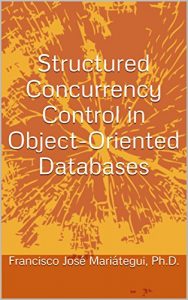In the last few years a number of object-oriented database systems have appeared in the literature, most of which addresses specific areas such as office information systems (OIS), computer aided design (CAD), computer aided manufacturing (CAM), software engineering (SE), and artificial intelligence (AI). Unfortunately, hardly any one of them addresses the problem of concurrency control from the general-purpose database point of view. Due to the extreme differences in types of transactions supported by these environments, the need for combining different concurrency control approaches has been recognized but never thoroughly investigated.
A high level design of a Multi-Group Multi-Layer approach to concurrency control for object-oriented message passing based databases is presented. The design follows a formal definition of transaction. The concurrency control takes advantage of the structured nature of transactions to manage an on line serializer. The serializer is specified as a set of filters. These filters are specifications of algorithms that ensure serializable histories. The concurrency control manages these histories by layers. Each layer, along with its corresponding filters, constitutes a different level of abstraction in concurrency control processing. Mutually exclusive groups of transactions being processed in parallel are assumed. The availability of a processor per group is also assumed. The performance is improved when this case of large granularity and limited interaction is applied. The decomposition of the histories into layers allows the problem to be more manageable, the principles of hierarchical design to be applied, and the benefits of hierarchical thought to be utilized.
Summarizing, this research has led to the following results:
1)First cut definition of an Object-Oriented Data Model (OODM) which encompasses data structures, operations, and integrity constraints.
2)Transaction processing model for the OODM environment, which facilitates not only definition of transactions but also, allows investigation of concurrency control.
3)Multi group Multi-Layer concurrency control technique built on the OODM and transaction models that allow the use of several different concurrency control techniques in parallel in the same environment.
A high level design of a Multi-Group Multi-Layer approach to concurrency control for object-oriented message passing based databases is presented. The design follows a formal definition of transaction. The concurrency control takes advantage of the structured nature of transactions to manage an on line serializer. The serializer is specified as a set of filters. These filters are specifications of algorithms that ensure serializable histories. The concurrency control manages these histories by layers. Each layer, along with its corresponding filters, constitutes a different level of abstraction in concurrency control processing. Mutually exclusive groups of transactions being processed in parallel are assumed. The availability of a processor per group is also assumed. The performance is improved when this case of large granularity and limited interaction is applied. The decomposition of the histories into layers allows the problem to be more manageable, the principles of hierarchical design to be applied, and the benefits of hierarchical thought to be utilized.
Summarizing, this research has led to the following results:
1)First cut definition of an Object-Oriented Data Model (OODM) which encompasses data structures, operations, and integrity constraints.
2)Transaction processing model for the OODM environment, which facilitates not only definition of transactions but also, allows investigation of concurrency control.
3)Multi group Multi-Layer concurrency control technique built on the OODM and transaction models that allow the use of several different concurrency control techniques in parallel in the same environment.






